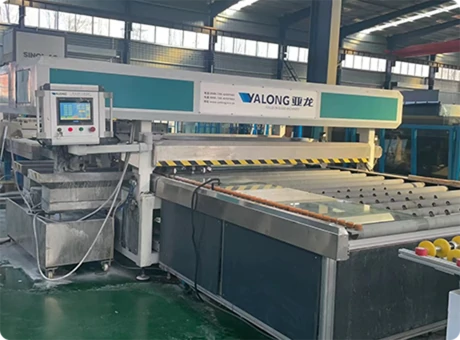Sheet glass manufacturing is a crucial process in the production of flat glass used in various applications, including windows, doors, mirrors, and screens. This manufacturing process has evolved significantly over the years, with advancements that enhance both efficiency and quality. The process can be broadly divided into several key stages melting, forming, annealing, and inspection.
The first step in the production of sheet glass is melting raw materials. The primary ingredients include silica sand, soda ash, and limestone, which are combined in specific proportions and heated to extremely high temperatures (approximately 1,700 degrees Celsius). This phase is conducted in large furnaces where the materials undergo a chemical transformation to form a molten glass. Energy efficiency is paramount in this stage, and manufacturers are increasingly adopting technologies that minimize energy consumption and enhance sustainability.
Once the raw materials are melted into a homogeneous liquid, the next phase is forming the glass. The most common method for producing sheet glass is the float glass process, invented in the 1950s. In this process, the molten glass is floated on top of a layer of molten tin, creating a smooth, flat surface. The glass naturally spreads out, forming sheets of uniform thickness. This method not only ensures a flat finish but also reduces the need for additional polishing. The thickness of the glass can be controlled by adjusting the speed at which it is drawn off the float bath.
sheet glass manufacturing process
After forming, the glass sheets must undergo an annealing process. Annealing involves slowly cooling the glass to relieve internal stresses that may have developed during forming. This is achieved by transporting the sheets through a controlled-temperature oven, known as an annealing lehr. This crucial step not only enhances the durability of the glass but also ensures that it meets safety and quality standards.
Once the glass has cooled, it goes through a meticulous inspection process. Quality control is essential in ensuring that the finished product meets the required specifications. Manufacturers employ both automated and manual inspection techniques to detect any defects such as bubbles, scratches, or distortions. Only glass that passes these stringent quality checks is packaged and dispatched for use in various applications.
In conclusion, the sheet glass manufacturing process is a complex interplay of raw material preparation, high-temperature melting, precise forming, controlled cooling, and rigorous quality inspection
. With continuous advancements in technology and a growing emphasis on sustainability, the industry is poised for further innovations, ensuring that sheet glass remains an essential material in modern architecture and design.
 Afrikaans
Afrikaans  Albanian
Albanian  Amharic
Amharic  Arabic
Arabic  Armenian
Armenian  Azerbaijani
Azerbaijani  Basque
Basque  Belarusian
Belarusian  Bengali
Bengali  Bosnian
Bosnian  Bulgarian
Bulgarian  Catalan
Catalan  Cebuano
Cebuano  Corsican
Corsican  Croatian
Croatian  Czech
Czech  Danish
Danish  Dutch
Dutch  English
English  Esperanto
Esperanto  Estonian
Estonian  Finnish
Finnish  French
French  Frisian
Frisian  Galician
Galician  Georgian
Georgian  German
German  Greek
Greek  Gujarati
Gujarati  Haitian Creole
Haitian Creole  hausa
hausa  hawaiian
hawaiian  Hebrew
Hebrew  Hindi
Hindi  Miao
Miao  Hungarian
Hungarian  Icelandic
Icelandic  igbo
igbo  Indonesian
Indonesian  irish
irish  Italian
Italian  Japanese
Japanese  Javanese
Javanese  Kannada
Kannada  kazakh
kazakh  Khmer
Khmer  Rwandese
Rwandese  Korean
Korean  Kurdish
Kurdish  Kyrgyz
Kyrgyz  Lao
Lao  Latin
Latin  Latvian
Latvian  Lithuanian
Lithuanian  Luxembourgish
Luxembourgish  Macedonian
Macedonian  Malgashi
Malgashi  Malay
Malay  Malayalam
Malayalam  Maltese
Maltese  Maori
Maori  Marathi
Marathi  Mongolian
Mongolian  Myanmar
Myanmar  Nepali
Nepali  Norwegian
Norwegian  Norwegian
Norwegian  Occitan
Occitan  Pashto
Pashto  Persian
Persian  Polish
Polish  Portuguese
Portuguese  Punjabi
Punjabi  Romanian
Romanian  Russian
Russian  Samoan
Samoan  Scottish Gaelic
Scottish Gaelic  Serbian
Serbian  Sesotho
Sesotho  Shona
Shona  Sindhi
Sindhi  Sinhala
Sinhala  Slovak
Slovak  Slovenian
Slovenian  Somali
Somali  Spanish
Spanish  Sundanese
Sundanese  Swahili
Swahili  Swedish
Swedish  Tagalog
Tagalog  Tajik
Tajik  Tamil
Tamil  Tatar
Tatar  Telugu
Telugu  Thai
Thai  Turkish
Turkish  Turkmen
Turkmen  Ukrainian
Ukrainian  Urdu
Urdu  Uighur
Uighur  Uzbek
Uzbek  Vietnamese
Vietnamese  Welsh
Welsh  Bantu
Bantu  Yiddish
Yiddish  Yoruba
Yoruba  Zulu
Zulu 

